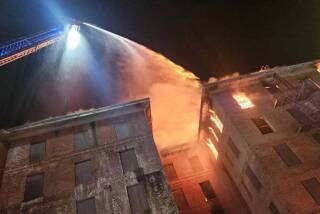Renovated Pico House Takes on New Colors
The once rundown Pico House, the first three-story building in the city of Los Angeles, has been given a face lift and now sports fresh gray and maroon shades, as part of renovation efforts at the historical site of El Pueblo de Los Angeles.
The Pico House was a hotel built in 1869-70 by Jesus de Pico, who had been the last governor of California when it was part of Mexico. It sits at El Pueblo, the conglomerate of 19th century buildings where the city of Los Angeles was born.
Seismic strengthening and exterior renovation of the Italianate-style Pico House, and others next to it, is well underway.
Alongside busy Main Street, the Pico building and two neighboring structures--the Merced Theatre and the Masonic Hall--stand out in newly applied shades of paint.
The theater is bathed in a light yellow with gray highlights and dark green trim. The Masonic Hall is light gray with brown highlights and trim.
âWe chose the colors closest to [our assessments from] black and white photographsâ of that period, said Jean Bruce Poole, historic museum director for El Pueblo de Los Angeles.
Poole, along with architects Luis Hoyos and Peyton Hall, picked the colors after studying the photographs âvery carefully,â she said.
âThey look good, clean; they present a vibrant look,â said Councilman Nick Pacheco, whose district includes the site. âI know they worked hard to figure out the colors.â
The sidewalks along adjacent Main Street are also undergoing changes. They are being widened to make the segment running past Olvera Street more pedestrian-friendly. The street will be narrowed from the current four lanes to three. Ficus trees are being replaced with smaller pepper trees, which add historical value as one of the earliest types of tree in Los Angeles, Poole said.
The work on Main Street and the Pico House should be completed by August, in time for the Democratic National Convention, Poole said. The Pico House is expected to be the site of a reception during the convention.
âWe are very excited about the fact that we are preparing [El Pueblo] for a mini-renaissance,â Pacheco said. âWeâre right on track to be done by the convention.â
The city plans to finish restoration of the entire site by 2001, and turn El Pueblo into a major historical and tourist attraction.
El Puebloâs plaza, just north of todayâs downtown, was the heart of Mexican society in the 19th century. During the early part of the 20th century, however, El Pueblo suffered from neglect as city leadersâ attention became diverted by the areaâs urban expansion.






